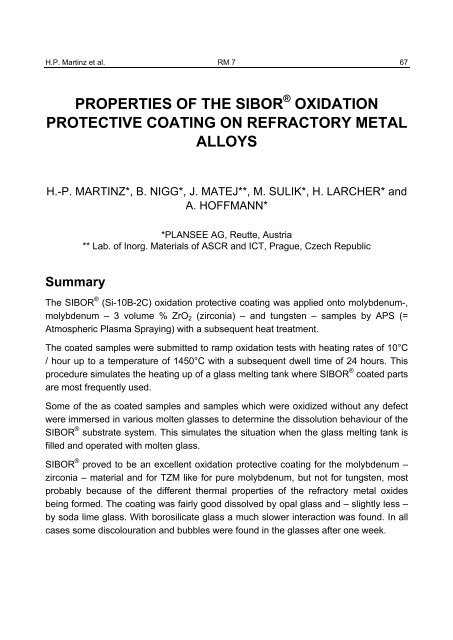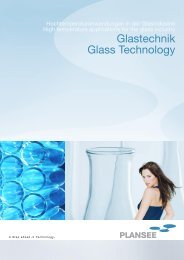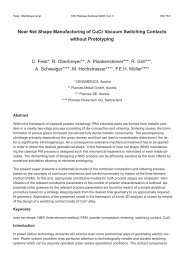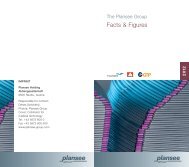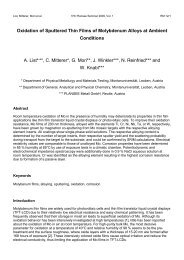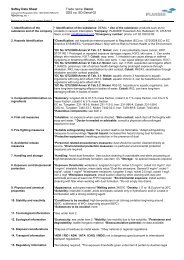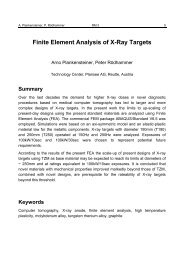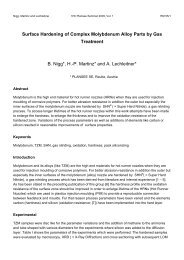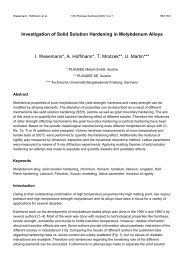PROPERTIES OF THE SIBOR® OXIDATION PROTECTIVE - Plansee
PROPERTIES OF THE SIBOR® OXIDATION PROTECTIVE - Plansee
PROPERTIES OF THE SIBOR® OXIDATION PROTECTIVE - Plansee
Create successful ePaper yourself
Turn your PDF publications into a flip-book with our unique Google optimized e-Paper software.
H.P. Martinz et al. RM 7 67<br />
<strong>PROPERTIES</strong> <strong>OF</strong> <strong>THE</strong> SIBOR ® <strong>OXIDATION</strong><br />
<strong>PROTECTIVE</strong> COATING ON REFRACTORY METAL<br />
ALLOYS<br />
H.-P. MARTINZ*, B. NIGG*, J. MATEJ**, M. SULIK*, H. LARCHER* and<br />
A. H<strong>OF</strong>FMANN*<br />
Summary<br />
*PLANSEE AG, Reutte, Austria<br />
** Lab. of Inorg. Materials of ASCR and ICT, Prague, Czech Republic<br />
The SIBOR ® (Si-10B-2C) oxidation protective coating was applied onto molybdenum-,<br />
molybdenum – 3 volume % ZrO2 (zirconia) – and tungsten – samples by APS (=<br />
Atmospheric Plasma Spraying) with a subsequent heat treatment.<br />
The coated samples were submitted to ramp oxidation tests with heating rates of 10°C<br />
/ hour up to a temperature of 1450°C with a subsequent dwell time of 24 hours. This<br />
procedure simulates the heating up of a glass melting tank where SIBOR ® coated parts<br />
are most frequently used.<br />
Some of the as coated samples and samples which were oxidized without any defect<br />
were immersed in various molten glasses to determine the dissolution behaviour of the<br />
SIBOR ® substrate system. This simulates the situation when the glass melting tank is<br />
filled and operated with molten glass.<br />
SIBOR ® proved to be an excellent oxidation protective coating for the molybdenum –<br />
zirconia – material and for TZM like for pure molybdenum, but not for tungsten, most<br />
probably because of the different thermal properties of the refractory metal oxides<br />
being formed. The coating was fairly good dissolved by opal glass and – slightly less –<br />
by soda lime glass. With borosilicate glass a much slower interaction was found. In all<br />
cases some discolouration and bubbles were found in the glasses after one week.
68 RM 7 H.P. Martinz et al.<br />
Keywords<br />
SIBOR, molybdenum, tungsten, oxidation protection, glass melt, dissolution<br />
1. Introduction<br />
SIBOR ® , a Si–B–C based APS – coating, initially developed as an oxidation protection<br />
system on molybdenum [1 – 6] for glass melting tank applications has been identified<br />
to be also of interest for the refractory metal materials W, TZM and Mo – ZrO2, which<br />
can be used in various other high temperature environments. Furthermore the<br />
experience with SIBOR ® on Mo showed that beside the oxidation protection during<br />
warm up of tanks also the solution behaviour of the coating system during the melting<br />
of the glass constituents in the first 1 - 3 weeks of the campaign plays a decisive role<br />
for the overall performance of the coated Mo parts. Especially the initial formation of<br />
gas bubbles and streaks should fade out by proper coating dissolution after about 10<br />
days to enable the start of the regular glass production in time.<br />
2. EXPERIMENTAL – GENERAL<br />
Samples of tungsten (W), molybdenum with low amounts of Ti, Zr, C and O (TZM),<br />
molybdenum – 3 vol.% zirconia (Mo -3 ZrO2) and molybdenum (Mo) were activated by<br />
sand blasting and covered with a typically 100 to 200 µm thick coating of SIBOR ® by<br />
APS (= Atmospheric Plasma Spraying). Subsequently the coating thickness of the<br />
cylinders was measured by eddy current technique. Then the parts were – with<br />
exceptions - submitted to a heat treatment in oxidation protective atmosphere at about<br />
1400°C.<br />
Subsequently some of the samples were checked for their oxidation protective effect<br />
mainly in a ramp oxidation test. In this test the specimens were heated in an air<br />
chamber furnace from room temperature to around 1450°C typically with a rate of 10°C<br />
per hour and hold there for 24 hours. This is a very tough load compared to an<br />
isothermal test at high temperature or a cyclic test with much faster heating rates as<br />
the coating spray porosity is closed much slower in ramp oxidation.<br />
The oxidized samples were weighed and partly submitted to a dissolution test in<br />
molten glasses (in case of Mo) or to a post-examination by cross sectioning, light<br />
microscopy (LiMi) and /or Scanning Electron Microscopy (SEM). The glasses being
H.P. Martinz et al. RM 7 69<br />
used for the dissolution tests were opal glass, white soda lime container glass and<br />
borosilicate glass at their practical melting temperatures. The duration of the<br />
experiments was (with interruptions) up to 168 hours (1 week), the evaluation was<br />
done for glass discoloration, bubble formation and consumption/reaction of the Mo-<br />
SIBOR ® -diffusion layers by Etching/Gravimetry, Stereo Light Microscopy (StLiMi),<br />
cross sectioning, LiMi and SEM/EDX (Energy Dispersive Analysis of X-Rays).<br />
3. EXPERIMENTAL DETAILS, RESULTS AND<br />
DISCUSSION<br />
3.1 TUNGSTEN / SIBOR – <strong>OXIDATION</strong><br />
W cylinders (Φ25 x 150 mm) were coated with Si-B-C to a thickness of at least 200 µm<br />
and then submitted to various treatments: pre-oxidation at 1300°C in air which led to<br />
spallation of the coating; annealing in hydrogen at about 1400°C with subsequent ramp<br />
oxidation test (250°C/h to 1000°C, holding for 2 hours) or isothermal test for 5 hours at<br />
1000°C: in the latter two tests development of smoke (WO3) and spallation of the<br />
oxidized coating could be observed.<br />
Consequently the actual part (a soldering aid body, Fig.1) was coated with 200 – 300<br />
µm Si-B-C by APS and submitted to a ramp oxidation test (250°C/h to 1000°C, then<br />
holding) without any pre-treatment. The result after 3.5 hours holding at 1000°C can be<br />
seen in Fig.1: complete spallation of the coating and strong growth of yellow W oxides<br />
– especially on the edges (see arrow).<br />
Fig.1: Macro of a SIBOR coated W part after ramp oxidation and holding at 1000°C
70 RM 7 H.P. Martinz et al.<br />
From these experiences must be concluded that W cannot be oxidation protected by<br />
Si-B-C or SIBOR (the especially heat treated Si-B-C coating). Probably the –<br />
compared to MoO3 – lower volatility of WO3 is responsible for this fact: during heating<br />
in the 400 to 800°C region inside the coating SiO2, B2O3 and refractory metal oxides<br />
are partly formed, evaporated and also reduced by C, which – in case of Mo – leads to<br />
a dense – MoO3-free (by evaporation) – protection layer. The cracks and pores are<br />
filled tightly with a soft SiO2 / B2O3 mixture. In case of tungsten the WO3 stays within<br />
the coating disturbing the protective action of the Si – B - oxides and starts to<br />
evaporate at about 700 to 800°C when the metal coating interface has already been<br />
poisoned by oxygen.<br />
3.2 TZM / SIBOR – CORROSION / <strong>OXIDATION</strong><br />
This system behaves very similar to the SIBOR – Mo couple, with the small deviation<br />
that the optimal coating thickness (concerning adhesion) is about 50 µm lower (100<br />
instead of 150). The reason probably is that TZM is containing oxides and carbides of<br />
Ti and Zr which may disturb the interaction of Si and B with Mo.<br />
Main interest for SIBOR coated TZM can be found in the molten aluminum (alloy)<br />
processing industry for parts like stirrers, thermocouple sheaths and channels where<br />
good creep resistance (advantage of TZM compared to Mo) and combined<br />
oxidation/corrosion resistance at temperatures up to 700°C are required. Up to now<br />
positive results could be gained from an industrial one week test at 620°C in AlSi7Mg<br />
melt with cylindrical samples (Ф15 x 200 mm) of SIBOR coated TZM compared to<br />
uncoated TZM and stainless steel 1.4301 (X5CrNi18 10).<br />
3.3 Mo – ZrO2 / SIBOR – <strong>OXIDATION</strong><br />
For applications with molten glass contact with TZM which is containing C is not<br />
suitable, because of CO bubble formation. But the C free, ZrO2 strengthened Mo alloy<br />
Mo-ZrO2 can be used and can improve the life times of Mo glass melting electrodes<br />
and Mo glass melting tank reinforcements because of its enhanced creep strength,<br />
bending strength – and – in some cases – glass corrosion resistance [7].<br />
The cylindrical samples (Φ50 x 100 mm) with chamfer (No. 1 to 5; Fig.5) or rounded<br />
edge (No. 6 to 7; Fig.5) were APS coated and annealed according to the SIBOR<br />
standard process for Mo except some modifications and variations in coating<br />
thickness and annealing position (Fig. 2 to 5).
H.P. Martinz et al. RM 7 71<br />
Fig.2: Macros of coated / annealed Mo-ZrO2 No. 3: top face (left), bottom face<br />
(centre) and circumference (right)<br />
Fig.3: Macros of coated / annealed Mo-ZrO2 No. 4: top face (left), bottom face<br />
(centre) and circumference (right); centre: large indentations from annealing<br />
Fig.4: Macros of coated / annealed Mo-ZrO2 No. 6: top face (left), bottom face<br />
(centre) and circumference (right); right: small indentations from annealing
72 RM 7 H.P. Martinz et al.<br />
No. (thickness) m before[g] test m after [g] test difference [mg]<br />
1 (050±30 µm) 1747,64 1746,96 -680<br />
2 (100±30 µm) 1773,01 1772,90 -110<br />
3 (150±30 µm) 1769,41 1769,60 190<br />
4 (200±30 µm) 1779,08 1777,57 -1510<br />
5 (250±30 µm) 1777,87 1774,28 -3590<br />
6 (200±30 µm) 1703,08 1703,43 350<br />
7 (200±30 µm) 1711,67 1712,04 370<br />
8 (200±30 µm) 1715,33 1715,76 430<br />
Fig.5: Table with planned coating thicknesses and mass change during ramp<br />
oxidation test<br />
All samples showed a perfect appearance after APS coating, but with annealing<br />
differences arose: no. 3 (relatively thin coating thickness) remained dull (Fig.2),<br />
whereas the samples 4 and 6 (with standard thickness; Fig. 3 and 4) became bright<br />
(with indentations from alumina supports). This effect is caused by a remaining molten<br />
/ solidified Si-B layer (outside the diffusion zones) and does not influence the<br />
performance of the SIBOR coating in case of Mo. But with Mo-ZrO2 in the subsequent<br />
ramp air oxidation test ( with 10°C/h from room temperature to 1450°C, then 24 hours<br />
dwell time with cooling in the switched off furnace) these samples were damaged by<br />
Mo – oxidation / sublimation at the indented zones (Fig. 5 and 7).<br />
Fig.6: Macros of oxidized Mo-ZrO2 No. 3: top face (left), circumference (right)
H.P. Martinz et al. RM 7 73<br />
Fig.7: Macros of oxidized Mo-ZrO2 No. 4: top face (left): oxidation damage;<br />
circumference (right): spallation without oxidation damage<br />
Fig.8: Macros of oxidized Mo-ZrO2 No. 6: top face (left), circumference (right): no<br />
oxidation damage<br />
The samples with thinner coatings (No.3; Fig.6), with rounded edge and smaller<br />
indentations from a horizontal annealing position (No.6 – 8; Fig.5 and 8) could<br />
withstand the oxidation test.<br />
Consequently as sprayed coatings with thicknesses between about 130 to 240 µm on<br />
parts with rounded edges and standard SIBOR annealing can be recommended for the<br />
oxidation protection of Mo – ZrO2.
74 RM 7 H.P. Martinz et al.<br />
3.4 SIBOR – Mo – DISSOLUTION in GLASS MELTS<br />
3.4.1 WHITE SODA LIME CONTAINER GLASS<br />
Three types of samples were tested:<br />
1. SIBOR coated Mo samples (denoted as “S” )<br />
2. Si-B-C coated but not heat treated Mo samples (denoted as “E” )<br />
3. Uncoated molybdenum (denoted as “M” )<br />
Four (in two cases only three) weighed samples were placed vertically into the quartz<br />
glass crucible containing the glass melt (white container glass typically with 71 – 75 %<br />
SiO2, 12 – 16 % Na(K)2O and 10 – 15 % Ca(Mg)O) containing 0.14 wt.-% SO3<br />
(sulphate refining) at 1300°C. The samples were held in the position by molybdenum<br />
wire protected by silica glass capillaries. After each 24 h step, the samples (except<br />
those destined for microanalysis) were taken out of the crucible, drawn off from the<br />
holder and dropped into water. The adhering glass was etched out by HF and weight<br />
loss was determined. The samples destined for microanalysis cooled freely on air<br />
together with the holder. Potential difference between SIBOR coated and uncoated<br />
sample was measured be means of the digital voltmeter with high input resistance<br />
connected to the molybdenum holders.<br />
Weight losses (differential values) for all the sample types are given in Fig. 9. It may<br />
be seen that the initial weight losses are very high both for SIBOR coated and for<br />
coated but not heat treated samples. It may also be seen that the values for both<br />
types of coated samples approximate to those for uncoated molybdenum between 3<br />
and 4 days. This may be compared with the time course of the potential difference<br />
measured between SIBOR (S6) sample and molybdenum (M4) in Fig.10. A good<br />
agreement in time courses of weight losses and potential difference courses may be<br />
seen. Concerning the non-heat treated samples, no conclusive difference between<br />
the behaviour of those and SIBOR samples can be demonstrated on the basis of the<br />
limited number of the data. It seems, however, that the values for non-heat treated<br />
samples approximate more rapidly to those for uncoated molybdenum.<br />
The values for SIBOR increase after the 5 th step. Presumably the SIBOR coating starts<br />
to split and separate, which might actually be observed on etched samples. This is<br />
probably caused by repeated cooling the sample together with the adhering glass layer<br />
with different thermal expansion.
H.P. Martinz et al. RM 7 75<br />
∆ m (g)<br />
0.07<br />
0.06<br />
0.05<br />
0.04<br />
0.03<br />
0.02<br />
0.01<br />
mass losses ∆ m vs.overall time<br />
M1<br />
0<br />
1 2 3 4 5 6 7<br />
S2<br />
S3<br />
E2<br />
S6<br />
time in days<br />
Fig.9: Diagram with mass losses (g) versus duration (days) of sample types M<br />
(uncoated Mo), S (SIBOR coated Mo) and E (Si-B-C coated, but not heat<br />
treated Mo samples) in white soda lime container glass<br />
Potential difference in mV<br />
600<br />
500<br />
400<br />
300<br />
200<br />
100<br />
Potential difference between Sibor and molybdenum (Sibor is more negative)<br />
0<br />
0 24 48 72 96 120 144<br />
Time in hrs<br />
Fig.10: Diagram with the potential difference (mV) between samples S6 (more<br />
negative / reactive) and M4 (more noble) versus time (hours).
76 RM 7 H.P. Martinz et al.<br />
Figures 11 to 13 show samples as they were removed from the melt after one day and<br />
a longer duration (4 to 8 days). In all cases a strong discoloration of the glass can be<br />
seen which is caused primarily by reactions of the SIBOR coating with glass melt.<br />
Fig.11: Macro of samples S5 (left, after 24 h) and S3 (right, after 8 x 24 h)<br />
Fig.12: Macro of samples E3 (left, after 24 h) and E2 (right, after 4 x 24 h)<br />
Fig.13: Macro of samples M5 (left, after 24 h) and M1 (right, after 8 x 24 h)<br />
In figures 14 to 16 the glass cullet is depicted after being removed from the samples by<br />
mechanical impact.<br />
Fig.14: Macros of cullet from S3 (after 8 x 24 h): SIBOR partly adherent to glass –<br />
darkening of the glass (arrow)
H.P. Martinz et al. RM 7 77<br />
Fig.15: Macros of cullet from E2 (after 4 x 24 h): SIBOR partly adherent to glass -<br />
darkening of the glass (arrow)<br />
Fig.16: Macros of cullet from M1 (after 8 x 24 h): interface partly adherent to glass –<br />
bubbles - darkening of the glass (arrow)<br />
It is remarkable that there is not so much difference between the cullets from the<br />
coated (Fig. 14 and 15) and the uncoated Mo sample (Fig.16) after 4 to 8 days: amber<br />
glass colour with a dark zone adjacent to the metal (already after 2 days). The<br />
explanation is: growing dominance of the reaction of Mo with the refining agent.<br />
The following figures (17 – 19) show cross sections of the metal – glass interface of the<br />
samples being depicted in figures 11 to 13.<br />
As can be seen in Figures 17 and 18 the dissolution of the coating systems is not yet<br />
finished after 192 and 96 hours respectively; A preliminary investigation in a parallel<br />
experiment at 1350°C indicates residual Si within the coating even after 168 hours. A<br />
more detailed EDX analysis will be performed to reveal the composition of the<br />
remaining coating “skeletons” of figures 17, 18. In case of Mo only small voids in the<br />
dense material are visible after 192 hours (Fig.19).
78 RM 7 H.P. Martinz et al.<br />
S19098_003<br />
S19098_005<br />
Fig.17: LiMi of a cross section of S5 (left) and S3 (after 24 and 8 x 24 hours<br />
respectively)<br />
S19098_009<br />
S19098_007<br />
Fig.18: LiMi of a cross section of E3 (left) and E2 (after 24 and 4 x 24 hours<br />
respectively)
H.P. Martinz et al. RM 7 79<br />
S19098_012<br />
S19098_011<br />
Fig.19: LiMi of a cross section of M5 (left) and M1 (after 24 and 8 x 24 hours<br />
respectively)<br />
3.4.2 OPAL GLASS<br />
In contrast to the soda lime corrosion tests only SIBOR coated Mo samples (Fig.20)<br />
were used; they were immersed into opal glass ( typical analysis: 67 % SiO2, 7 %<br />
Al2O3, 0.1 % Fe2O3, 0.4 % MgO, 4.8 % CaO, 13.3 % Na2O, 2.2 % K2O, 1.6 % BaO and<br />
5.9 % F ) in alumina crucibles at 1350°C. Every 24 hours the glass melt was renewed.<br />
Fig.21 shows samples and glass after 24 and 168 hours. The glass becomes<br />
transparent and much less discoloured and opaque within one week. But there are still<br />
bubbles visible in the glass.<br />
Fig.20: Macros of sample 3 (top and bottom view); all samples were cut from larger<br />
SIBOR coated Mo plates
80 RM 7 H.P. Martinz et al.<br />
Fig.21: Macros of sample 1 (left, after 24 hours) and sample 7 (right, after 168<br />
hours) plus cullets of opal glass (above the samples)<br />
Fig.22: LiMi of cross sections of the metal – glass interface of samples 1 (left) and 3<br />
(right) after a test duration of 24 and 72 hours respectively
H.P. Martinz et al. RM 7 81<br />
Fig.23: LiMi of a cross section of sample 7 (after 168 h; left); SEM/BS of the same<br />
sample (right), EDX: all points show only Mo, but zone 3 (arrow) contains<br />
most probably B, which is not detectable.<br />
Conclusively SIBOR on Mo was not dissolved completely in opal glass within one<br />
week. However, the remaining porous Mo “skeleton” is Si free, only below in the<br />
substrate rests of a – presumably B containing – diffusion zone could be found. This -<br />
compared to soda lime glass – more advanced dissolution state is most probably<br />
caused by the high alkali fluoride content and is in agreement with practical<br />
experience.<br />
3.4.3 BOROSILICATE GLASS<br />
For the borosilicate glass dissolution experiments a typical commercial laboratory glass<br />
cullet with the composition 81 % SiO2, 13 % B2O3, 4 % Na(K)2O and 2 % Al2O3 (wt %)<br />
was molten and kept at 1450°C. In this series SIBOR coated Mo samples were used,<br />
after being pre-oxidized by air ramp oxidation at 1450°C and dwelling for 24 hours.<br />
Fig.24: Macros of samples and cullet of numbers 1, 3, 5 and 7 (from left) after 24,<br />
72, 120 and 168 hours respectively
82 RM 7 H.P. Martinz et al.<br />
Fig.25: LiMi (left) and SEM/BS (right) of the metal – glass interface of sample 1<br />
(after 24 hours); EDX (from left): point 1: Mo; points 2 and 3: Mo, Si (Mo5Si3)<br />
Fig .26: LiMi (left) and SEM/BS (right) of the metal – glass interface of sample 7<br />
(after 168 h); EDX (from left): point 1: Mo; point 2: Mo, Si (Mo5Si3), point 3:<br />
Mo, Si (Mo3Si), point 4: Mo (arrow)<br />
Figures 24 to 26 show that SIBOR is reacting only slowly with borosilicate glass. After<br />
one week the outer, porous region has lost Si (transformation of Mo5Si3 to Mo3Si and<br />
Mo), but the inner zones remained unchanged. This behaviour most probably is<br />
caused by the high temperature of the glass which enhances the formation of thick and<br />
dense diffusion layers. Furthermore the low alkali metal content of the borosilicate<br />
glass is responsible for a weaker reaction with Si. However, there are indications that
H.P. Martinz et al. RM 7 83<br />
differently composed borosilicate glasses can attack and dissolve SIBOR-Mo much<br />
faster.<br />
4. CONCLUSIONS<br />
The Si-B-C oxidation protective coating was applied to tungsten - , TZM - ,<br />
molybdenum – 3 vol. % zirconia and molybdenum - samples by APS (= Atmospheric<br />
Plasma Spraying) and partly with a subsequent heat treatment (SIBOR ® ).<br />
Some of the coated samples were submitted to ramp oxidation tests with heating rates<br />
of 10°C / hour up to a temperature of 1450°C and subsequent dwelling for 24 hours.<br />
This procedure simulates the heating up of a glass melting tank where SIBOR ® coated<br />
parts are most frequently used. SIBOR ® coated Mo – ZrO2 behaved almost identically<br />
as standard coated SIBOR ® / Mo and could therefore be used in cases of higher creep<br />
load. TZM also can be protected by SIBOR ® coating with potential applications in the<br />
molten aluminum process technology. SIBOR ® on W does not work because of the<br />
different properties of W oxides.<br />
As coated, heat treated and partly oxidized Mo samples were immersed into various<br />
molten glasses to determine the dissolution behaviour of the SIBOR ® substrate<br />
system. This simulates the situation when the glass melting tank is filled and operated<br />
with molten glass. SIBOR ® / Mo is most easily dissolved by the alkali and fluoride rich<br />
opal glass; next is the alkali rich soda lime glass with a slightly lower reactivity.<br />
Borosilicate glass with the lowest alkali content of the glasses being tested reacts only<br />
slowly with the SIBOR ® / Mo system. In no case the coating could be completely<br />
dissolved within one week. Bubbles and discolouration can be found in the glass in all<br />
cases even after this period. So it depends on the time scale of the production start<br />
and the glass specifications concerning bubbles and discolorations if SIBOR ® - coated<br />
Mo parts can be used.<br />
References<br />
[1] H.-P. Martinz, J. Matej, G. Leichtfried, Proceedings of the 15th <strong>Plansee</strong> Seminar,<br />
Reutte, 2001, pp. 217 – 228.<br />
[2] H.-P. Martinz, J. Matej, M. Sulik, Proceedings of the 12th Conference on electric<br />
and other highly efficient ways of glass melting, Tabor, 2001, pp. 71 – 81.
84 RM 7 H.P. Martinz et al.<br />
[3] M. Sulik, H.-P. Martinz, Glass International, 2000, pp. 22 – 25.<br />
[4] M. Sulik, H.-P. Martinz, International Glass Review, 2000, pp. 58 – 62.<br />
[5] H.-P. Martinz, M. Sulik, Advances in Fusion & Processing of Glass – 6th<br />
International Conference, Ulm, 2000.<br />
[6] J. Disam et al., Proceedings of the 14th <strong>Plansee</strong> Seminar, Reutte, 1997, pp.<br />
269 - 286.<br />
[7] D. Gohlke et al., Proceedings of the 14th <strong>Plansee</strong> Seminar, Reutte, 1997, pp.<br />
51 – 66.


